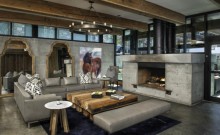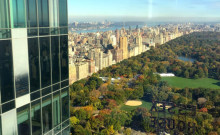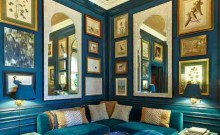A spread in the 1973 issue of Architectural Digest showcased the Patiños’ private bowling alley.
Bowling may date from ancient Egypt, but in recent years the sport that led Henry Clay Frick to install an alley in his Fifth Avenue hôtel particulier—it’s still there, in the basement of what is now the Frick Collection museum—hasn’t had much of an A-list reputation. Still, every so often, word of an elegant private bowling alley comes to one’s attention, a venue so posh that one wonders why the game doesn’t come back into fashion rather than being played at home on a Nintendo Wii. Which, I confess, I have done—but only on holiday at a friend’s house, I swear.
Back in 1973, Architectural Digest actually devoted four pages to a bowling alley. There were mitigating circumstances, naturally. The alley in question was located inside a purpose-built pavilion on an estate near Estoril, Portugal, an exclusive oceanfront enclave about 15 miles west of Lisbon. The clients were one of the grandest couples of the day—Antenor Patiño (1896–1982), heir to a multimillion-dollar Bolivian tin fortune, and his Franco-Spanish second wife, Beatriz (1905–2009), a woman who once donned, a reporter observed, “a diamond necklace so blinding it should have been viewed through smoked glass.” Rembrandts and Holbeins clustered on their paneled walls, and one of the last great balls of the 20th century was held in 1968 at their Estoril residence, known as Quinta Patiño. It was an event so splendid—interior decorator Valerian Rybar (1919–1990) and his partner, Jean-François Daigre (1946-1992), cushioned the gravel garden paths with lobster-red carpeting for the comfort of the thousand-plus guests—that Taki, the acerbic society observer, joked it “probably had a lot to do with the subsequent Portuguese military uprising.”
The kind of life lived at Quinta Patiño obviously demanded a certain kind of bowling alley. So in the 1960s, Rybar, a master of staggering sumptuousness, conjured a neo-Portuguese Baroque fantasia that a friend of the Patiños called “quietly spectacular, like everything Rybar does, of course. And guests find the bowling chic and innovative.” Given that the pavilion—Rybar served as architect and decorator—featured just one lane with an electric Brunswick bowling system, “innovative” might not be quite the right word. “Chic,” though, certainly qualifies.
Painted white inside and out and floored with herringbone brick with creamy stone borders, the building was a stage-set riff on Portugal’s Manueline style of the 16th century, with graceful scalloped windows and a ceiling segmented with groin vaults, all trimmed with ropelike plaster details. Torchères lined the slightly sunken wood alley, along with low benches for viewing. To one side, a games area offered iron bridge tables by the Paris firm Jansen (its director Stephane Boudin was another decorator patronized by the Patiños) and velvet-covered folding chairs that were practically a Rybar hallmark. Flanking this were two seating areas, each with a white sofa and armchairs (one suspects they swiveled, given the time period) and matching needlework carpets. Relieving the white-and-brown palette were potted bay trees, all symmetrically placed on either side of every door, window, and arch.
So far, so glamorous. But a closer look reveals a subtle thematic motif that ties the space together, somewhat literally. The architecture’s twisted-rope detail was echoed in the piping on the sofas, chairs, and benches, the pattern of the carpets, even the twirly legs of the wood easel holding the chalk scoreboard. Some might call it matchy-matchy; I call it seriously chic.







